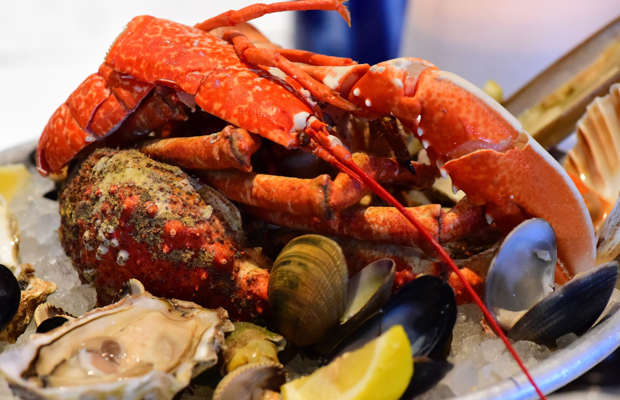© (Getty Images)If you expect a dish like this when you order Rocky Mountain oysters, you're in for a surprise.
Don't be fooled by these misnomers on the menu.
1. Buckwheat
Although it gets
treated like a grain similar to rice, buckwheat is actually a fruit seed that is related to rhubarb and sorrel. In spite of its name, it doesn't contain any wheat at all, which makes it a perfect swap for those who are
sensitive to wheat or grains that contain gluten. Buckwheat has been shown to reduce cholesterol levels and it's also associated with helping to stabilize blood sugar levels. It's also a good source of magnesium, which may assist in reducing blood pressure.
2. Sweetbreads
Not sweet. Not bread. Rather, sweetbreads are actually either the thymus gland or pancreas of a lamb, cow or pig. This organ meat has a unique smooth, creamy texture and a somewhat bland taste. Whether baked, breaded, fried or braised, if you have a hankering for a chocolate croissant, sweetbreads will not do the trick.
I know from experience. The first (and last) time I tasted them, I was at a party and my sister turned to me with a twinkle in her eye and a smile on her face. She asked me if I'd like to try sweetbreads. She knew I
loved breads and sweets, so to me, it was a no-brainer (pun intended). After my first bite of the squishy substance, she announced I had just eaten "brains" – a far cry from a pastry!
3. Egg Cream
If you grew up in Brooklyn, New York, as I did, you probably know that a delicious frosty egg cream contains neither egg nor cream. This nostalgic summer thirst-quencher has been around since the 1930s, but you don't need to call your grandmother for the recipe – it's a cinch to prepare. With only three ingredients – namely chocolate syrup, milk and seltzer – you can whip up an egg cream in no time. Use
skim milk instead of whole types and go easy on the syrup to shave calories without compromising taste.
© bhofack2/iStock/Getty Images
4. Cream Cheese
Although cream cheese is essentially a cheese, it doesn't compare to the (much better) nutrient profile of hard cheese. One tablespoon of cream cheese contains 0.9 grams of protein and 14.2 milligrams of calcium, whereas a slice of hard cheese provides about 7 grams of protein and 200 milligrams of calcium.
5. Apple butter
One of my patients swore off apple butter because of its cholesterol content. Rest assured, apple butter has
no cholesterol, since it doesn't contain any butter. Apple butter is primarily a concentrated form of applesauce that also has sugar and sometimes cinnamon.
6.Hamburgers
I don't need to tell you this, but
hamburgers are not made with ham. Some say the sandwich was named for the city Hamburg in Germany, but others claim that it first attracted attention via a vendor at the 1904 World's Fair in St. Louis. In either case, the traditional hamburger is typically made using ground meat, such as beef or turkey, along with a medley of other ingredients to enhance its flavor. These days, veggie burgers are popular; however, they range in quality – some are composed of healthy, whole foods like beans and veggies, while others are made with more processed soy blends. Check labels to see what you're really getting.
© (Getty Images)If you expect a dish like this when you order Rocky Mountain oysters, you're in for a surprise.
Plant-based pros dish on what to know before trading steak for fake.Vandana Sheth’s vegetarian lifestyle used to represent a niche market. Now, she’s mainstream. “It used to be just one or two brands [of meat alternatives], but now … there’s aisles and aisles of them,” says the Academy of Nutrition and Dietetics spokeswoman, who is based near Los Angeles. For the most part, that’s a good thing: Plant-based diets are the gold standard of health and environmental responsibility – and Americans are apparently eating them up. But not all meatless meats are created equal. Here’s what to know before going faux:
© bhofack2/iStock/Getty Images
Packaged meat alternatives with names like “Chik’n Nuggets,” “Beef (Not!)” and, of course, Tofurky, are great “gateways” to a more plant-based lifestyle, says Sharon Palmer, a.k.a. “The Plant-Powered Dietitian” and a contributor to U.S. News's Eat+Run blog. One survey, she points out, showed that while only 7 percent of consumers consider themselves vegetarian, 31 percent are trying to cut back on meat. “If meat alternatives can help people [do that,] it’s still so much better for the environment” than animal products, she says. Sheth also applauds such products’ convenience. And, unlike old varieties’ rubbery texture, “a lot them are tasty,” she adds.
© (Getty Images)
But “not meat” leaves a lot of room for what the products actually are. “It’s important to remember that just because something is vegetarian or plant-based doesn’t automatically make it healthy,” Sheth says. Many of these products include preservatives and additives – think tapioca starch, cellulose, xanthan gum and TBHQ, a compound that prevents discoloration – to make them flavorful and shelf-stable, and to imitate a meaty texture. A word to the wise: “Look for ingredients that you would find in your own kitchen,” Palmer suggests. She and other plant-based pros also recommend keeping these five tips in mind:
© (Getty Images)
If you only swap your Kobe burger for a vegetarian variety on Meatless Monday or at a plant-based pal’s barbecue, you won’t shake your overall nutrient intake much. But if you’re regularly trading meat for “meat,” keep in mind that the latter often packs a fraction of the protein of the former, Palmer says. “People just assume they’re a protein replacement,” she says, “but they could have other ingredients in there like brown rice.” Palmer recommends products with close to 12 grams of protein – still about one-quarter of the protein in an 8-ounce beef patty.
© (iStockPhoto)
Today’s plant-based products have come a long way from original meat alternatives sculpted from soy. One manufacturer, Beyond Meat, recently announced a vegan "burger" apparently so meat-like it's said to be sold in refrigerated cases alongside the real thing. Other burgers are so minimally processed that "you can actually see beans in them,” Palmer says. “I like that trend.” She also supports soy products because soy is so nutrient-rich. Beans and lentils are Sheth’s pick for “best base,” while (mostly) vegetarian food blogger Grace Poser’s current favorite is pea protein (the base of Beyond Meat's new burger), which has 15 grams of protein per serving, a “neutral” taste and is “highly digestible,” she says. Finding what works for you, they say, may come down to trial and error.
© (Getty Images)
It’s not just strange-sounding fillers and protein content to look for on faux meat labels. Also keep an eye out for sugar, sodium, fat and calorie content. “That’s where some of these could be very high because they’re trying to mimic the flavor and mouthfeel that you’re missing,” says Sheth, who recommends limiting your sodium to 500 milligrams and fat to 10 grams. People with allergies to soy, gluten or nuts should label-read with caution, as should vegans, since egg and the milk protein casein are common binders, notes Rachel Morris, a vegan food blogger in Arlington, Virginia.
© (Getty Images)
More important than what makes up your faux patty is what makes up your overall diet. “The goal is a wide variety,” Sheth says, noting that you don’t want packaged meats – animal or plant-based – to be your main source of protein or any nutrient, for that matter. "Whenever you don't eat the whole food, you do lose some things," such as protein and fiber, Palmer points out. Rather than a premade bean patty, try a scoop of black beans and a side of rice or quinoa, Poser suggests. Just keep in mind: "Nothing is going to taste exactly like meat unless it is meat, so you have to ... appreciate the ingredient for what it is," she says. "Tempeh is its own beautiful thing, and it doesn't have to be a steak."
© (Getty Images)
If you’re still craving that meaty feel but prefer to steer clear of packages, try whipping up your own plant-based burger – Poser makes one with nothing but tempeh, egg and harissa – or grilling or roasting squash, eggplant or mushroom to fill the void. Seasoning vegetables with spices such as cumin and smoked salt is one of Poser’s secrets for satisfying the meat tooth she developed growing up in a German family but has denied since meeting and cooking with her vegetarian husband. She hasn’t looked back. “You can make a meal taste like nothing’s missing,” she’s found, “when there’s no meat on the plate.”
© mauinow1/iStock/Getty Images
7. Fruits de Mer
If you've seen this term on a French menu, don't expect to get a medley of fruit. It actually translates to "fruits of the ocean" – in other words, a melange of seafood.
8. Rocky Mountain Oysters
On the flip side, don't expect any seafood when you order this dish. In reality, it's an appetizer made of deep-fried bull, pig or sheep testicles. Bon appetit!
Copyright 2016 U.S. News & World Report

 © bhofack2/iStock/Getty Images
4. Cream Cheese
Although cream cheese is essentially a cheese, it doesn't compare to the (much better) nutrient profile of hard cheese. One tablespoon of cream cheese contains 0.9 grams of protein and 14.2 milligrams of calcium, whereas a slice of hard cheese provides about 7 grams of protein and 200 milligrams of calcium.
© bhofack2/iStock/Getty Images
4. Cream Cheese
Although cream cheese is essentially a cheese, it doesn't compare to the (much better) nutrient profile of hard cheese. One tablespoon of cream cheese contains 0.9 grams of protein and 14.2 milligrams of calcium, whereas a slice of hard cheese provides about 7 grams of protein and 200 milligrams of calcium.











0 Comments